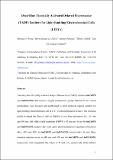Deep-blue thermally activated delayed fluorescence (TADF) emitters for light-emitting electrochemical cells (LEECs)
Abstract
Two deep blue thermally activated delayed fluorescence (TADF) emitters ( imCzDPS and imDPADPS ) that contain charged imidazolium groups tethered to the central luminophore were designed and synthesized as small molecule organic emitters for light-emitting electrochemical cell (LEEC) electroluminescent devices. The emission profile in doped thin films (5 wt% in PMMA) is very blue and narrow (λPL: 414 nm and 409 nm; full width at half maximum (FHWM): 62 nm and 46 nm for imCzDPS and imDPADPS , respectively) with good photoluminescence quantum efficiencies (ФPL: 44% and 49% for imCzDPS and imDPADPS , respectively). In neat films, emission maxima occur at 440 nm and 428 nm for imCzDPS and imDPADPS , respectively with comparable ΦPL values of 44 and 61%, respectively. Both emitters exhibit biexponential emission decay kinetics (nanosecond prompt and microsecond delayed fluorescence) in both MeCN solution and thin film, characteristic of TADF behaviour. While imDPADPS did not show any emission in the LEEC device, that of imCzDPS gave an electroluminescence (EL) maximum at 470 nm and CIE coordinates of (0.208, 0.250), which makes this device amongst the bluest reported to date. However, the maximum device luminance achieved was 2.5 cd m-2 and this poor brightness was attributed to the electrochemical instability of the emitter in LEEC architecture, as evidenced by the additional peak around 550 nm observed in the EL spectrum.
Citation
Wong , M Y , La-Placa , M-G , Pertegás , A , Bolink , H J & Zysman-Colman , E 2017 , ' Deep-blue thermally activated delayed fluorescence (TADF) emitters for light-emitting electrochemical cells (LEECs) ' , Journal of Materials Chemistry C , vol. 5 , no. 7 , pp. 1699-1705 . https://doi.org/10.1039/C6TC04821H
Publication
Journal of Materials Chemistry C
Status
Peer reviewed
ISSN
2050-7526Type
Journal article
Description
The authors acknowledge the University of St Andrews for financial support. The authors also acknowledge financial support from the European Union H2020 project INFORM (grant 675867), the Spanish Ministry of Economy and Competitiveness (MINECO) via the Unidad de Excelencia María de Maeztu MDM-2015-0538, MAT2014-55200 and the Generalitat Valenciana (Prometeo/2016/135). MLP acknowledges support from a Grisolia grant (GRISOLIA/2015/A/146).Collections
Items in the St Andrews Research Repository are protected by copyright, with all rights reserved, unless otherwise indicated.

